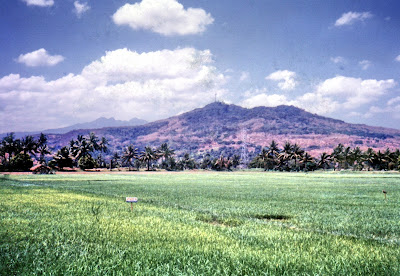 |
| The Memorial Cross |
Come Holy Week, I was invited by Jandy’s teacher Ms. Veneriza “Vener” Trillo to vacation at their home at Morong in Bataan. That being the case, I also planned to make a stopover at the Dambana ng Kagitingan in Pilar. Its giant cross, on the 553-m. high Mt. Samat, stands as a mute symbol of the heroic World War II resistance put up by Filipino-American forces against the invading Japanese 60 years ago. A visit to Bataan is certainly meaningless without seeing it. On this pilgrimage, I brought along my son Jandy, his classmate Jeff Agtonong, teachers Mr. Erwin Vizcarra and Mr. Ronnie Boy Lansangan plus Ms. Marianne de Guzman, Ronnie’s friend.
We left Manila very early in the morning (4 AM) of April 17 (Holy Thursday), taking the longer (150.40 kms. from the Balintawak flyover) route along Bataan’s east coast instead of the shorter Subic Bay Metropolitan Authority (SBMA) route. Normally it would take 3 hrs. tops to travel the said distance, but hey, this is Holy Week and heavy traffic is the rule and not the exception. It was everywhere, from the North Luzon Expressway (NLEX), then being widened, all the way up to Lubao in Pampanga. The Lubao section (then being rehabilitated) was the worst, with over an hour wasted. After Lubao, it was smooth driving all the way as we entered Bataan, the Roman Superhighway and the Angel Linao Highway, to Pilar town. Along the way, we passed the entrance to Dunsolan Falls, located along Mt. Samat’s western slope, and Mt. Samat Inn. Upon reaching the Mt. Samat turn-off, it was a steep drive up a 7-km. long winding asphalt road. We finally reached the shrine by 10 AM.
 |
| The colonnade of Dambana ng Kagitingan |
The shrine, at the end of the road, is located just 70 m. below the mountain’s peak. It was built at a cost of PhP7 million (including access roads) and was opened on April 9, 1974, the anniversary of Bataan’s fall (Araw ng Kagitingan). Our pilgrimage to the shrine was done nearly 30 years after the fact. Today, the Araw ng Kagitingan held at the shrine usually features wreath-laying ceremonies, remembrance of the Death March and tributes to World War II veterans, whether dead or still living.
 |
| The base of the cross |
Immediately above us, reached by a long flight of stairs, is the shrine’s marble-capped colonnade. It has an altar, an esplanade and a museum. The shrine’s 12 relief columns, done in marble, depict historical events and important battles that took place in Bataan. The altar, used for religious services, has a stained-glass mural behind it. There are also statues of war heroes, two bronze urns (symbolic of the Eternal Flame of Freedom) and 18 bronze insignias and flagpoles with colors of USAFFE division units. What struck the eye; however, were the two huge panels on the north and south walls inscribed with accounts of the Battle of Bataan in relief. The colonnade’s basement museum, reached by a spiral stairway, displays an array of authentic World War II American and Japanese weapons (rifles, machine guns, mortars, shells, bayonets, etc.), uniforms (helmets, boots, belts, etc.), old photos, news clippings and, in the center of the dimly-lit hall, a scaled 3-D model of the Bataan peninsula indicating important battle sites.
 |
| The museum |
Upon finishing our museum tour, we crammed our necks up to look at our ultimate destination: the towering Memorial Cross. From the colonnade, we made the long but leisurely walk up the 14-flight zigzagging footpath (paved with bloodstones from Corregidor Island) on the mountain slope to the cross. Once up, I found out that we could have drove all the way up to a parking lot beside it. Some exercise (in futility?) it turned out to be as I later walked down the winding road to fetch the car. The cross was huge, 91.8 m. high to be exact. Built in 1968 with steel and reinforced concrete, it stands on an 11 meter high platform capped with nabiag na bato slabs sculpted with bas reliefs depicting significant battles and historical events. Above this base, the cross is finished with chipped granolithic marble. Its 30 m. wide arms (15 m. on each arm) rise 74 m. from the base and can be reached by an elevator.


